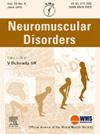Assessing disease progression in spinal muscular atrophy, current gaps, and opportunities: a narrative review
IF 2.7
4区 医学
Q2 CLINICAL NEUROLOGY
引用次数: 0
Abstract
Spinal Muscular Atrophy is a genetic disorder causing muscle atrophy and progressive weakness. People living with the condition can have a significant heterogenous phenotype ranging from arrest of motor development to mild impairment. Assessing disease severity has been done using a range of outcome measures that can be classified by body structure or function, by activities or by participation. Functional outocome measures can be generic measures, used to compare individuals or populations against general norms, or disease-specific measures designed to fit disease characteristics. Outcome measures assessing participation are primarily used to capture patients' perceptions of health-related quality of life, daily activity abilities, caregiver burden, and the impact of physical symptoms like fatigue or pain. When assessing disease progression, often the focus on functional abilities has served as an overall indicator of change. With the appearance of disease modifying therapies and the need to evaluate the impact that they had in the course of the disease, new requirements for the existing assessments measure had appeared. The current available toolkit is able to capture a significant spectrum of both, natural history and effect of new treatments but the increased survival, changes in fatigue, bulbar function and others will benefit from further assessment.
评估脊髓性肌萎缩症的疾病进展,目前的差距和机会:叙述性回顾
脊髓性肌萎缩症是一种遗传性疾病,导致肌肉萎缩和进行性无力。患有这种疾病的人可能有明显的异质性表型,从运动发育停止到轻度损伤。评估疾病严重程度使用了一系列可按身体结构或功能、活动或参与程度进行分类的结果测量。功能性结局测量可以是通用测量,用于将个体或群体与一般标准进行比较,也可以是设计用于适应疾病特征的疾病特异性测量。评估参与的结果指标主要用于捕捉患者对与健康相关的生活质量、日常活动能力、照顾者负担以及疲劳或疼痛等身体症状的影响的看法。在评估疾病进展时,通常将重点放在功能能力上,作为变化的总体指标。随着疾病修饰疗法的出现以及需要评估它们在疾病过程中的影响,出现了对现有评估措施的新要求。目前可用的工具包能够捕获新治疗的自然历史和效果的重要范围,但增加的生存率,疲劳的变化,球功能和其他方面将受益于进一步的评估。
本文章由计算机程序翻译,如有差异,请以英文原文为准。
求助全文
约1分钟内获得全文
求助全文
来源期刊

Neuromuscular Disorders
医学-临床神经学
CiteScore
4.60
自引率
3.60%
发文量
543
审稿时长
53 days
期刊介绍:
This international, multidisciplinary journal covers all aspects of neuromuscular disorders in childhood and adult life (including the muscular dystrophies, spinal muscular atrophies, hereditary neuropathies, congenital myopathies, myasthenias, myotonic syndromes, metabolic myopathies and inflammatory myopathies).
The Editors welcome original articles from all areas of the field:
• Clinical aspects, such as new clinical entities, case studies of interest, treatment, management and rehabilitation (including biomechanics, orthotic design and surgery).
• Basic scientific studies of relevance to the clinical syndromes, including advances in the fields of molecular biology and genetics.
• Studies of animal models relevant to the human diseases.
The journal is aimed at a wide range of clinicians, pathologists, associated paramedical professionals and clinical and basic scientists with an interest in the study of neuromuscular disorders.
 求助内容:
求助内容: 应助结果提醒方式:
应助结果提醒方式:


